Most of you know Shaa’ir and Func’s Monica Dogra as the poet and the performer, the musician with the moves; but have you met her as the runner, the chef, the seeker, the worker bee who’s passionate, hardworking, and driven? In conversation, the real Monica Dogra tells her story.
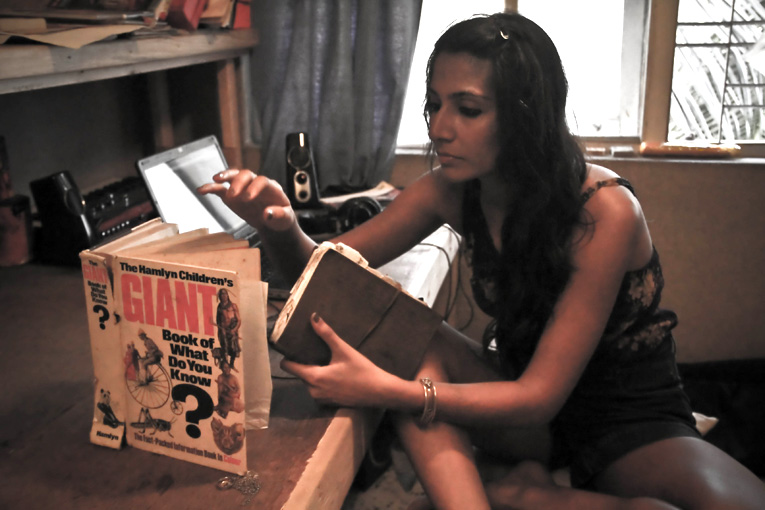
The real Monica Dogra. Photograph by Monisha Ajgaonkar.
As the Shaa’ir or poet, where would you say your poetry comes from? What is your inspiration?
I find a lot of things in life are pre-instinctual; it’s just a matter of trusting your instincts enough to let your inner voice speak. So sometimes it comes from that place, sometimes it comes from a more conscious space where I’m just trying to sort out my head and my heart. And sometimes, it comes from that very deep place that if you interrupt it, then it doesn’t come anymore.
While performing a song, how do you revive the sentiment you had when you wrote it? Do you have a stage ritual or trigger?
Not really. In term of performance, the only thing that is ritualistic is that I stay really healthy. When I get on stage, I enter into a space where I am relatively free of ego, and really excited to expose myself. People have a tendency to put on a mask; it’s really rare that you communicate purely, either your problems or your thoughts or your love or your story sincerely. And I think what going on stage does for me is [that] it gives me a space to strip down to this one energy that transmits purely without ego, without any other real intention, but to be the true self.

“When I get on stage, I enter into a space where I am relatively free of ego.” Photograph by Monisha Ajgaonkar.
That sounds deep. How did you get there?
When I went to N.Y.U. to study music, I became absolutely no one in New York. I learned to love what I did, even thought I wasn’t the best at it. The most valuable lesson was learning to love music, learning to love my words and my story, without them being received, without them giving me anything and without someone saying “you’re awesome”. Music, for a very long time, gave me nothing. No recognition, no friends. In fact I lost friends and was distanced from my family because of it. But that was undying, selfless love and that that’s what sets me apart. I also learnt that love is not about reciprocity. Your job is to love and just keep loving, no matter what. If I could learn to love somebody unconditionally, the way I love music, I’d be sorted.
How did you deal with all the negativity from people who were close to you?
When you get rid of all of that junk—because it’s just junk—when you forget all the human stuff, then you’re able to elevate yourself into a space where it’s impossible not to feel the music, no matter what people say. Music is divine. And I definitely think I arrived at a place where whether or not anybody was listening, I was still going to sing. I was still going to do it and with as much love and desire as if the whole world was giving me everything that I desired.
How do you manage to keep yourself healthy on tour?
I’m not so good with routine. I feel like if I can master routine, my life would get better. But I make sure that I eat really well. I really love cooking, so I eat healthy. And I exercise quite a bit. If it’s not running, then it’s yoga or pilates or mohiniyattam (dance). Gigging tends to keep me in shape, too. On tour, one of my favourite things to do is to run in a new place. So I went to Oslo, and I ran around Oslo. I ran around London and Amsterdam, and that’s how I could see the place. I’m a rubbish runner, but I still do it wherever I go, because half of the fun is in getting a little lost.
I’m passionate about staying fit because I get thrown out of my cycle while performing, if I can’t breathe or I’m so tired from how much I want to move. My body needs to be able to withstand the amount of movement and singing that I do at the same time—it’s actually quite hard.
When did you begin dancing? And what forms do you practise?
I’ve always been a dancer, since I was a child. I studied ballet for eight years, tap for four, modern, lyrical, and jazz in college, kathak for five years, mohiniyattam for two. What moving does for me is that it removes thought: when my body moves, I don’t think. That’s why I move round so much and why we rehearse so much, so that I don’t have to think; my body just works on auto-spiritual-pilot from all the muscle memory. But it takes a tremendous amount of energy to get there. And usually I’m a very self-conscious person, but I’ve figured out a way to trick myself into losing my ego; so if I’m nothing then there’s nothing to be self-conscious about.
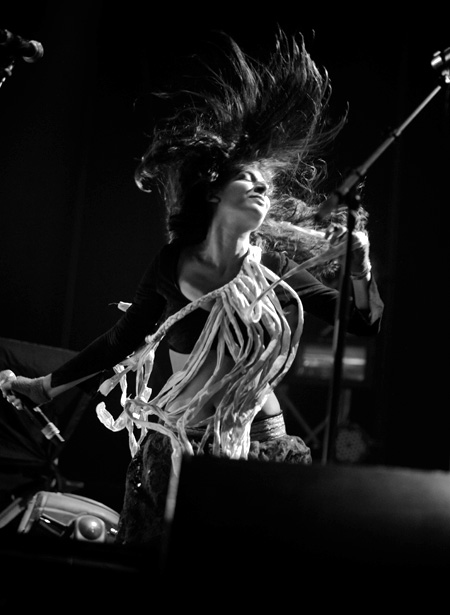
Monica Dogra with Midival Punditz at the Eristoff Invasion Festival. Photograph by Shiv Ahuja/NH7.
How did you get your visual stage persona together?
It’s many different things; since the release of Mantis, I’ve seriously upped my game. Lately I’ve worked with a lot of interesting people who’ve offered me help because they love our music. A lot has changed, especially from meeting this one really talented, rather high-profile make-up artist, Elton Fernandes. And I think he felt quite excited to work with somebody as eccentric as me. I’d painted my face before [I met] him, but he creates a work of art. I give him the context and he materialises it in a way that I wouldn’t be able to. For instance, before Mantis was released, I messaged him to say, “Do you think you could draw my eyes kinda seeping light? Like tears, but shiny! Like something that’s hopeful, like tears that goodness comes out of?”
Was that the emotion for Mantis?
For both Randolph and I, Mantis was the deconstruction and reconstruction of so many things, in our personal lives and music lives. I wanted the make-up to say that there’s goodness that comes out of all destruction. And Elton did such a beautiful job.
I really liked the earthy body paint you had on for the gig at Bonobo (in Bombay) last month. Would you tell us how it came to be?
A few days before the gig, I was thinking about how the world is changing: the local and international revolution, the earthquakes, tsunamis, the 2012 conspiracies, the prophecies. At the end of the day, everything that we’ve built is nothing; we are nothing. I remember saying “I’m nature’s bitch”, so I asked Elton if he could draw a leaf on my face, going into a tree which is growing out of my body. And an artist friend of mine, Kunal, drew the tree.
For me, the visual element is cathartic, it helps me get into a mental space, to visually realise things. It also draws the audience in; every show I want to make sure that I touch somebody in the artist community. The stage is all about the natyashastra. I come from a world of theatre, where if you can expand your audience’s attention through something visual, it’s wonderful; for example Katy Perry‘s ‘Smell-O-Vision’ thing is a total work of art. Our body receives stories through our senses. If you can see something and also hear it, smell it, and taste it, then that is the ultimate artistic experience. Maybe I’ll bring food to the next gig. (Giggles)
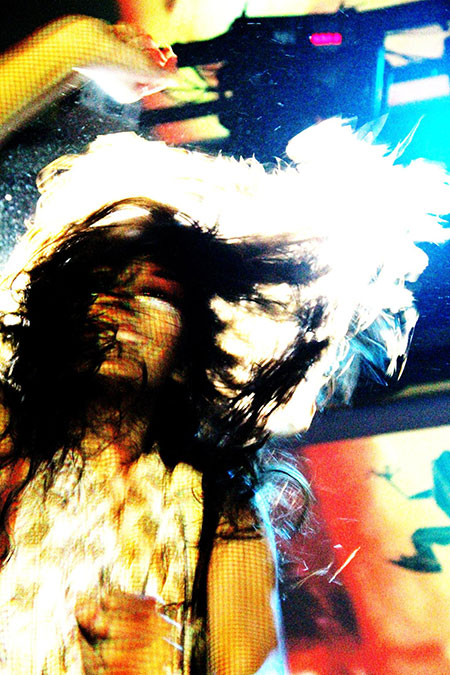
“I’m also highly emotional, although these days I’ve found ways to channel my insanity.” Photograph by Monisha Ajgaonkar.
Why did you choose to move to Bombay?
I didn’t; Bombay chose me. I spent five days here and so many things happened; I met so many musicians. When I left, I just felt like there was something in Bombay. I didn’t know what it was, but I needed to find out. So I came back. And that’s the one thing that I’ve always been good at, listening and paying attention: if there’s a sign, I promise I’ll have the balls to go for it. I’ll do whatever it takes; just tell me what to do. And I’ve always gotten signs.
How do you find the signs?
I just listen really hard. And I have the guts. I have so many friends with artistic tendencies who say, “I wish I could have”, or “How did you…”. I just did, you know? It was really hard, but I took a chance, and I trusted when there was really no proof that things would work out; but I made it work out. It sounds like a cliché, but it’s true.
What’s your take on religion and spirituality?
I was raised Hindu, and my late grandfather, Pt. Parshuram Shastri, was actually a priest in Jammu. But I’ve noticed is that religion has become a vehicle for inhibiting people, especially creative people like artists, actors, and writers, from expressing themselves. So I’ve shied away from it, but I’m insanely spiritual because I’ve experienced what the power of believing in something can do. I know the power of listening really closely for signs and just following my destiny. I’m also highly emotional, although these days I’ve found ways to channel my insanity. I believe that there are energies that we can bend if we become really strong and wise. And I think that through music, I’ve figured out a way to do that a little bit.
I feel like I was perfect when I was 12, and then I spent from 12 to 23 just messing myself up. But from then, I’ve been trying to get back to that 12 year old. She was pretty awesome.
Is this what you meant by “deconstruction”? Do you think you achieved that with Mantis?
I don’t know if we achieved it, but I definitely think that Mantis is the best album we’ve ever put out. The best songs are on Mantis, it has the best production we’ve ever done. As a cohesive work of art, it has a beginning, a middle and an end, the way all good stories do. It was a really deep album, I think that some of the lyrical content is the best I’ve ever written; it came from a very transient and scary place.
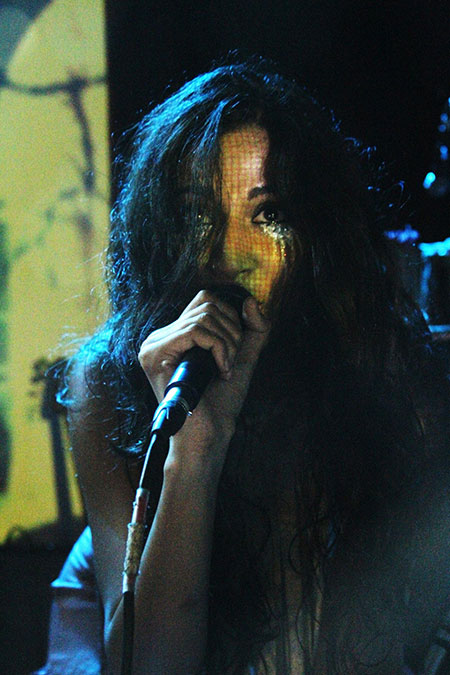
“Mantis is the best album we’ve ever put out.” Photograph by Monisha Ajgaonkar.
What was it like creating Mantis?
Mantis was something that we set out to do indefinitely. We just kept listening to the signs, we kept making music, we even threw out about five or six songs. We started gigging our material before we finished it. Every song went through many, many versions. For example, the version of ‘Goodbye Cruel World’ on the album is the eighth revision.
And that’s why we called it Mantis, cause it was the prophet, it was the seer, it knew something that we didn’t and we just had to keep going until we got that magic answer, that “okay, you’re done!”, which took two years.
So how do you conceptualise an album? And have they all come out as concept albums?
No, not really. Well, New Day: The Love Album was a lifetime of experiences that came together; Light Tribe came from a year on the road, playing lots of dance stages at some of the biggest festivals in the world, and wanting to be able to rock a dance floor. And then Mantis is something that we started without really knowing what it was going to become, but some of the best stories, the best journeys have begun that way, right?
What is the process involved in creating any Shaa’ir and Func album?
I’d have to talk to for like a hundred days. It’s not one thing. It’s Randolph’s practices to always be writing beats and it’s mine to always be writing poems. Sometimes he’ll send me something, which I’ll listen to and that will trigger a memory of something I’ve written, that becomes a song. Sometimes it’s from jamming.
What is your equation with Randolph?
I think Randolph and I complete each other, in a way. We went to The Big Chill music festival in Goa and there was this hippie guy with a really huge book of dates. It had something that governs you, your positive and negative poles and your east and west. And I was literally the moon and he was the sun; whatever was my positive was his negative, and whatever was my east was his west. The guy was shocked, he said, “I’ve never seen two people like this ever in my life…”. I’ve worked with other people and so has he, but there’s no one I’ve ever worked with who brings out my ideas, who I can realise my dreams with, the way that I can with him. And I think he feels the same.
I’d never even touched a computer for production before; I didn’t have any interest in producing, but I can now. I can play guitar if I want to; he gave that to me. Similarly he has no real interest in writing lyrics, but he actually wrote ‘Every Time You’re Around’ and ‘Lord Inside’. And he says that I’m his greatest inspiration, in that he would never otherwise be interested in melody. He came from the school of thought where vocals were really unnecessary. Randolph has seen me through my most formative years, and I’ve seen him through crazy moments in his life. He’s my best friend. There’s no one in the world who will ever be what he is to me. The equation just works, it just does, as long as we don’t interrupt it or try to define it. Honestly speaking, I don’t know if other people could do what we do, but perhaps if they had three album babies like we’ve had, they would understand.
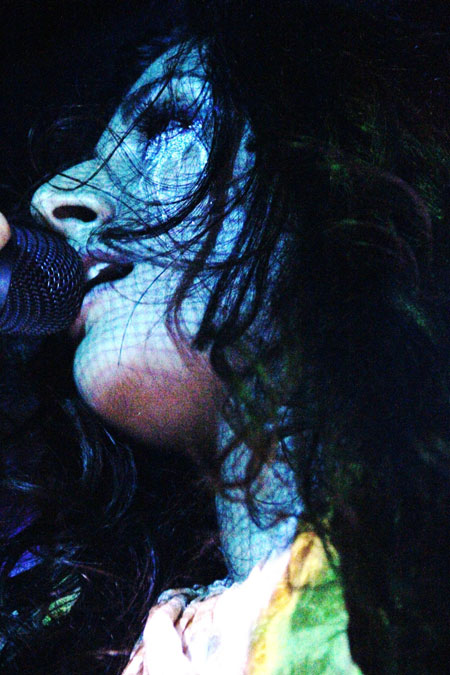
“The most valuable lesson was learning to love music, learning to love my words and my story.” Photograph by Monisha Ajgaonkar.
You said you’re a very emotional person. What keeps you happy these days?
Everything! I’m pretty happy these days, which is really quite exciting. It’s kind of a weird time in my life—I’m actually the happiest I’ve ever been. I get really happy when I’m getting good at something. And I can always tell if I suck.
Perhaps you’re judging yourself too harshly…
No, I’m rubbish at most things, until it’s specifically ‘my thing’ and then I work really hard to get good at it. I’m not one of those people who just wake up and go, “Oh, I’m awesome!” Those people make me want to slap them so hard ’til kingdom come, and I know so many of them. I do a lot because I’m rubbish at most things but I work so hard that I get further fastest. I’m the workhorse: I practise, I struggle hard, and then repeat. And I always remember where I came from. That’s what I bring to every show: ‘My Roots’ is about that in many ways.
Do you think you berate yourself too much?
Yeah, I have a very horrible disease. It’s called self-loathing.
How do you rise above it?
I admit it. I keep admitting it. I write songs about it. I think that most creative people have a good amount of self-loathing inside of them. And why they need to create is to make the world around them and themselves better. It comes from the image of satisfaction that you get from changing your environment, and that’s why we create. ‘Freeze You’, for instance, is about that. It’s about building something so that you can live that fantasy in your mind; creating something that isn’t, because what is isn’t good enough. I don’t know; you’re never done bettering yourself, right?
What does the future hold for you?
For me, it’s definitely about touching more minds, communicating to a larger audience, making a better life, making better art. And I’m really focused on writing that one song that you can play on repeat through an entire day without getting sick of it, before I die.
You can download Mantis for free at this location.






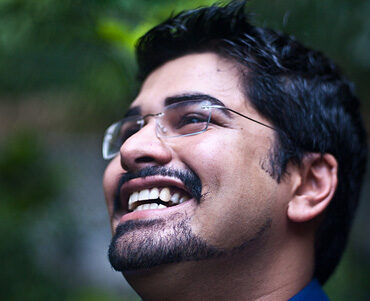


Wow………….
Brilliant.. :)
i love whatever she does
brilliat. love her mind.